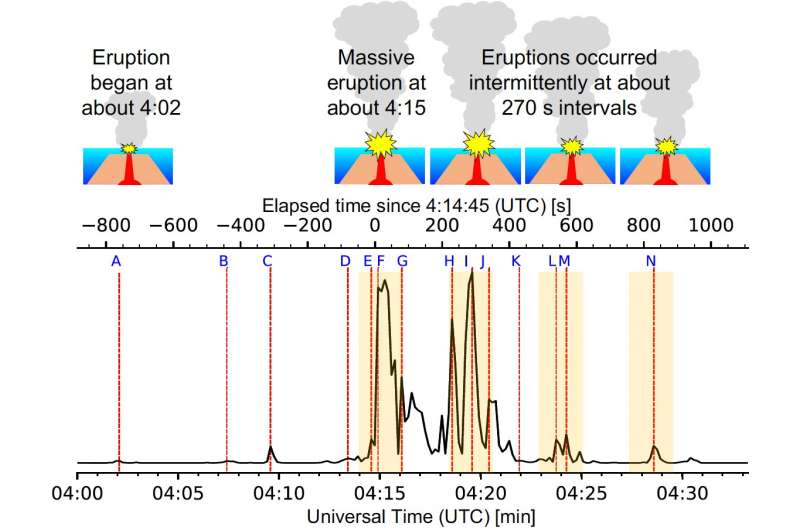This article has been reviewed according to Science X's editorial process and policies. Editors have highlighted the following attributes while ensuring the content's credibility:
fact-checked
peer-reviewed publication
trusted source
proofread
Looking back at the Tonga eruption

A new analysis of seismic data recorded after the massively violent eruption of the underwater volcano Hunga Tonga-Hunga Ha'apai, on January 15, 2022, has revealed new and useful information on the sequence of events. Kotaro Tarumi and Kazunori Yoshizawa at Hokkaido University discuss their methods and findings in an article in Earth and Planetary Science Letters.
"We showed that the eruption consisted of two distinct sequences of events, some of which occurred quasi-periodically in the first sequence. It will be worthwhile to investigate the mechanisms involved in such eruption cycles further," says seismologist and geophysicist Yoshizawa.
The volcano generated seismic, tsunami and atmospheric waves that were recorded worldwide. Recent studies have estimated that it was one of the most energetic eruptions recorded by modern instruments.
"Eruption episodes are difficult to analyze fully from seismic surface waves, but we have teased out more details using what are called teleseismic-P waves," says Ph.D. student Tarumi. These are seismic waves that have traveled through the planet to locations distant from the eruption site. In this case, the team used seismic data collected from sites as far as at a 93-degree angle around the circumference of the planet.
The team's "back-projection" analysis successfully detected the locations and timing of multiple explosions, even though P-waves from each eruption overlapped and were masked by other seismic signals and noises.
The back-projection technique reverses the transmission of seismic signals to reveal details of a potential source that radiated seismic waves. It was originally developed and applied for imaging the source processes of large earthquakes, but is now proving equally applicable to large scale volcanic events.
The results revealed that the sequence of eruptions occurred in two main parts. The first sequence began at 04:02 UTC on January 15, then escalated into major explosions at 04:15 UTC and 200 to 300 seconds after. The entire sequence lasted at least until 04:35 UTC.
A second sequence of eruptions began about four hours later and continued from six to seven minutes, including a massive eruption at 08:31. Satellite imagery recorded the resulting dramatic ash cloud from the first eruption sequence, but until now the precise details of the underwater events have remained elusive.
One interesting finding was that significant explosive eruptions intermittently occurred at 270 to 280 second intervals, a frequency suggesting a resonance effect with the atmosphere and the Earth. "This apparent agreement of the eruption cycle and the atmospheric resonant oscillation with the Earth could be coincidental, but it certainly deserves further exploration," Yoshizawa concludes.
More information: Kotaro Tarumi et al, Eruption sequence of the 2022 Hunga Tonga-Hunga Ha'apai explosion from back-projection of teleseismic P waves, Earth and Planetary Science Letters (2023). DOI: 10.1016/j.epsl.2022.117966
Journal information: Earth and Planetary Science Letters
Provided by Hokkaido University





















